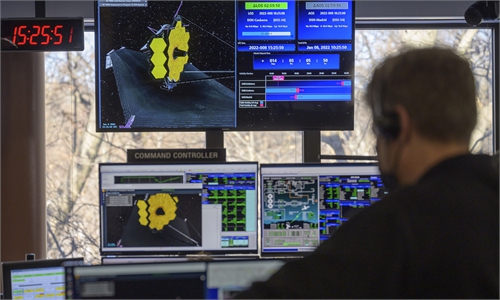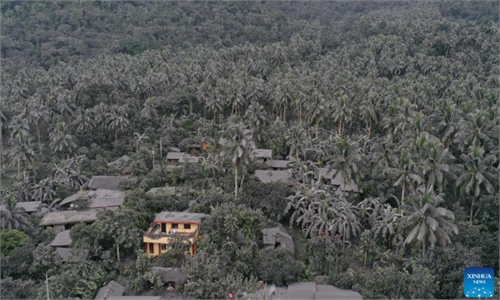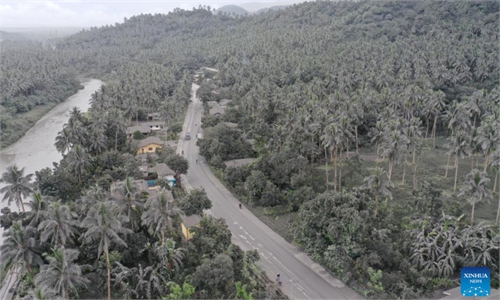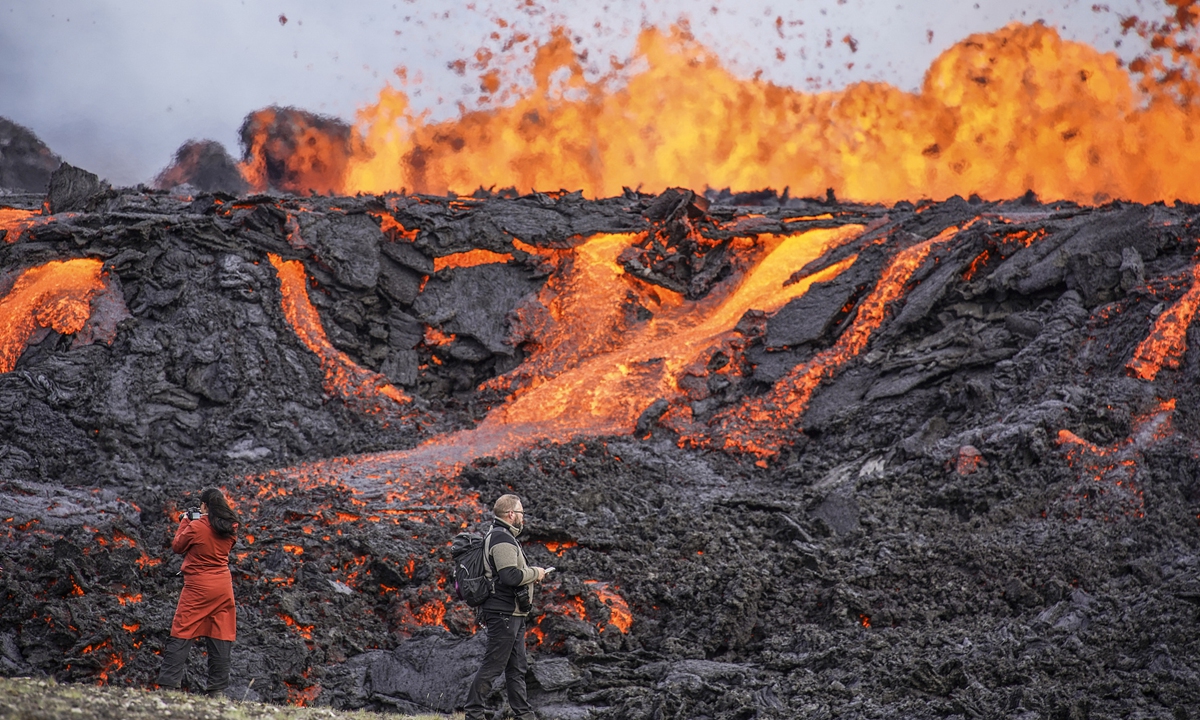
Lava flows from the Fagradalsfjall volcano in Iceland on August 3, 2022. Photo: VCG
A volcano erupted in Iceland on Wednesday near the capital Reykjavik, spewing red hot lava and plumes of smoke out of a fissure in an uninhabited valley after several days of intense seismic activity.The eruption was around 40 kilometers from Reykjavik, near the site of the Mount Fagradalsfjall volcano in southwestern Iceland that erupted for six months in March-September 2021, mesmerizing tourists and spectators who flocked to the scene.
On Wednesday, a strip of glowing red lava could be seen gushing from the ground, spouting 20-30 meters into the air before spreading into a blanket of smouldering black rock.
As it cooled, blueish smoke rose up from the hilly landscape on the Reykjanes peninsula.
About 100 curious onlookers quickly made their way to the scene, bewitched by the sight of the bubbling lava and the intense roar that could be heard rising up from the ground as the lava erupted, an AFP reporter at the scene said.
The Icelandic Meteorological Office (IMO), which monitors seismic activity, estimated the size of the fissure at about 300 meters.
It said the eruption started in the Meradalir valley, less than one kilometer from the scene of last year's eruption.
Wednesday's eruption came after a period of intense seismic activity, with about 10,000 earthquakes detected since Saturday, including two with a magnitude of at least 5.0.
While there was no ash plume, the IMO said it was "possible that pollution can be detected due to the gas release."
Gases from a volcanic eruption - especially sulphur dioxide - can be elevated in the immediate vicinity, and may pose a danger to health and even be fatal.
Gas pollution can also be carried by the wind.
"Risk to populated areas and critical infrastructure is considered very low and there have been no disruptions to flights," the Icelandic foreign ministry said on Twitter.
Tourist magnet
Last year's eruption saw more than 140 million cubic meters of magma spilled into the area over a period of six months before it was officially declared over after nine months, in December 2021.
Relatively easy to access, the site became a major tourist attraction, drawing more than 430,000 visitors, according to the most recent figures from the Icelandic Tourist Board.
Wednesday's eruption was believed to be five to 10 times bigger than last year's eruption, with about 20-50 cubic meters of magma spewing out per second, Magnus Tuma Gudmundsson, professor of geophysics at the University of Iceland, told Icelandic media.
On Wednesday, rescue teams and police rushed to the scene to assess the danger and possible gas contamination, and discouraged people from visiting.
Awakening
Mount Fagradalsfjall belongs to the Krysuvik volcanic system on the Reykjanes peninsula in southwestern Iceland.
Known as the land of fire and ice, Iceland has 32 volcanic systems currently considered active, the highest number in Europe.
The country has had an eruption every five years on average.
And Wednesday's eruption was the country's seventh one in the past 21 years.
However, until last year, the Reykjanes peninsula had not experienced an eruption since the 13th century, when a volcano erupted for 30 years from 1210 to 1240.
Geophysicists have said that the 2021 eruption could signal the beginning of a new period of eruptions lasting centuries.
A vast island near the Arctic Circle, Iceland straddles the Mid-Atlantic Ridge, a crack on the ocean floor separating the Eurasian and North American tectonic plates.
The shifting of these plates is in part responsible for Iceland's intense volcanic activity.
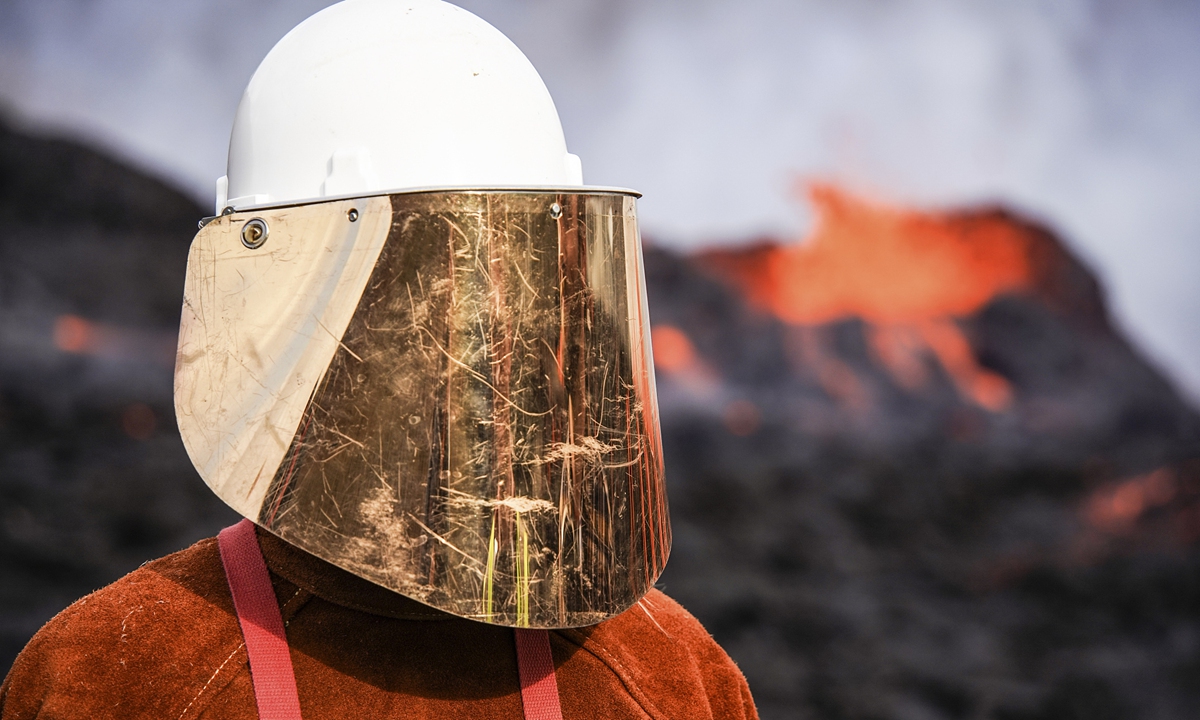
A person in protective gear stands close to the lava flowing from the Fagradalsfjall volcano in Iceland on August 3, 2022. Photo: VCG
